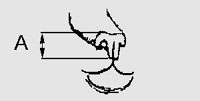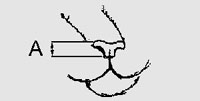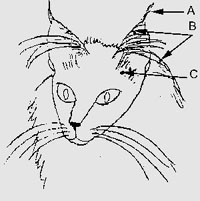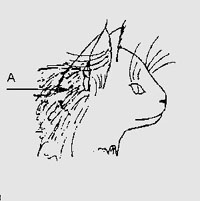|
|
|
|
The NFC Expression - A forgotten trait?
Ever since the Norwegian Forest Cat was recognized as a separate breed there has been talk about the correct NFC expression, the NFC look. What is it really? How does one describe the correct look? Which traits are particularly important for this look?
The
expression
of the NFC is determined by a number of traits such as the shape of the head the
profile, the set of the ears and their size, and the eyes. In the following I
will concentrate on the length of the profile, the width of the nose and the
setting and size of the eyes. The reason why I choose to concentrate on these
aspects is that they are not well defined in the Standard of Points in spite of
the fact that they are of primary importance to the NFC look.
To get the best possible
expression a description of the NFC head ought to run something like this:
The triangular head, where all sides are equally long, is of medium size.
The profile is long and straight with the length of the nose a little shorter than the length of the forehead.
|
|
|
|
The forehead is slightly rounded and should be flat at the centre.
beginning to round between the ears.
The transition between the flat forehead, the rounded crown and the back of the head is without indentations and breaks.
The eyes are big and open, slightly oval in shape and slightly obliquely set. The upper and lower rims of the eye should be uniformly curved with no sections of straight lines. The eyes are not deep-set, and are placed so that the distance between them corresponds roughly to the width of an eye.
The nose is wider between the eyes than at the tip.
The nose slopes so that the bridge of the nose grows gradually wider from the tip to the beginning of the cheek bone, and should ideally be totally without pinch.
The chin is strong, and seen in profile it should ideally be in line with the upper lip.
REASONING:
Big, heavy cats with small heads do not have the correct balance between head and body.
When the lower part of the face becomes too long in comparison with the forehead it becomes too dominant and the cat gets a sleepy look.
If the forehead is not flat at the centre the profile cannot be quite straight.
It is true for all breeds that the most beautiful head shape occurs when the section between the ear is rounded (more or less depending on the breed).
and when the crown and the back of the head is uniformly rounded with no indentations.
There are many possible eye shapes and settings, but the one described here makes for the most alert and correct NFC expression.
| |
Horizontally set eyes - |
|
|
Eyes with a straight upper rim
- |
|
|
 |
Too oval eyes - |
|

|
Too round eyes - |
|

|
Correct NFC eyes |
|
|
|
A) Width of nose between the
eyes |
|

|
Rounded nose
|
|

|
Flat nose - squarish look,
wide
|
|
|
|
A) Pinch |
|
The ears - an important part of the NFC look
SETTING
The ears should be placed so on the head that the outer rim of the ear continues the triangular shape of the NFC head.
|
|
The ears continue the line from the chin and the cheeks |
|
The most common error in this connection is ears set too high. This gives a typical "moggle" look.
|
|
Ears set too high on the head |
|
Moreover it is important in ? to achieve the correct alert expression that the ear well be placed so on the head that it slants a bit forward-outward. Ear well placed so that they face straight forward give the NFC a much too gentle and sweet expression.
|
|
Head seen from above: |
|
|
|
KHead seen from above: |
Moreover the ear well must be straight and not droop forward towards the eyes as this often results in a cross expression.
|
|
Ears with correct upright ear wells A) depth of the ear well |
|
|
|
Wrong placing of the ears |
|
SIZE
The size of the ear consists of three things: Height, width and depth.
The height seems at first quite easy to asses, however, it is ALWAYS necessary to feel the outline of the ear where it fastens on to the skull.
EARS WITH CORRECT FUR SEEM SMALLER THAN EARS WITH LITTLE FUR;
OR EARS THAT LACK HAIR AT THE BASE OF THE EAR WELL;
AND/OR LACK OF HAIR ON THE BACK OF THE EAR.
One of the reasons for this optical illusion is that the light is easier to see through an ear well with little fur, and that it is easier to see all of the pale ear well when the hairs in front of the ear are missing. The ear well should have a good depth at the base and a good width in the opening. Narrow ear wells give wrong, tight look and lack depth at the base.
|
|
Good wide ear well A) Width of ear well |
|
|
|
zToo narrow ear well |
|
SHAPE
The most handsome NFC ears have pointed outlines. There are NFC's with quite rounded ear tips which reminds one of the ears of Burmese. When breeding NFC's one should aim at pointed ears partly because it gives a more alert expression, partly because the hairs in the tufts gather together more on a pointed ear.
|
|
Pointed outline of ear |
|
|
|
Too rounded outline of ear |
|
FUR
The fur contributes to give the NFC ear the perfect look. The NFC is claimed to be a nature cat adjusted to a cole climate, and such a cat has a course developed a good amount of fur about the ears to reduce heat loss. In front of the ear the NFC often has quite long hairs which hide the ear well partially, and all along the inner rim of the ear well hairs of varying length grow with the shortest near the tip of the ear. These hairs in front of the ear and along the inner rim will nearly cover the inner part of the ear, thus protecting it against the cold, flying insects and what else might be able to penetrate a naked ear. At the back of the ear lots of fur is quite important, too. As a rule one can say that dense fur should go up to and preferably past the area where the outer rim of the ear is double. This fur grows gradually longer near the base of the ear to merge naturally with the beginning of the ruff. The last touch is the tufts on the ear tips. Big, good tufts give a handsome finishing touch to the ear and the correct "wild" look.
The NFC ear and its surroundings should have lots of fur.

|
A) Lynx tuft |
|

|
A) fur at the back of the ear well |
|
With frendly permission by Jette Eva Madsen, Danish NFC breeder (Felis Jubatus) and semi-longhair judge in FIFe. ©1990
Translated to english by Birgit Hartoft, editor of "Huldrekatten", club magazine for the Danish NFC Club, Norsk Skovkattering.
Translated to german, supplemented and with pictures completed by Eva Ewald, german NFC breeder (v.Tim-Est) and publisher of "Rassekatzen-Jahrbuches". © 03/2002